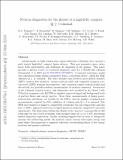Neutron diagnostics for the physics of a high-field, compact, Q ≥ 1 tokamak
Author(s)
Tinguely, Roy Alexander; Rosenthal, A.; Simpson, R.; Ballinger, S.; Creely, Alexander James; Frank, S.; Kuang, A. Q.; Linehan, B. L.; McCarthy, W.; Milanese, L. M.; Montes, K. J.; Mouratidis, T.; Picard, Julian F.; Rodriguez Fernandez, Pablo; Sandberg, A. J.; Sciortino, Francesco; Tolman, Elizabeth Ann; Zhou, M.; Sorbom, Brandon Nils; Hartwig, Zachary Seth; White, A. E.; ... Show more Show less
DownloadAccepted version (870.8Kb)
Publisher with Creative Commons License
Publisher with Creative Commons License
Creative Commons Attribution
Terms of use
Metadata
Show full item recordAbstract
Advancements in high temperature superconducting technology have opened a path toward high-field, compact fusion devices. This new parameter space introduces both opportunities and challenges for diagnosis of the plasma. This paper presents a physics review of a neutron diagnostic suite for a SPARC-like tokamak [Greenwald et al., 2018, https://doi.org/10.7910/DVN/OYYBNU]. A notional neutronics model was constructed using plasma parameters from a conceptual device, called the MQ1 (Mission Q ≥ 1) tokamak. The suite includes time-resolved micro-fission chamber (MFC) neutron flux monitors, energy-resolved radial and tangential magnetic proton recoil (MPR) neutron spectrometers, and a neutron camera system (radial and off-vertical) for spatially-resolved measurements of neutron emissivity. Geometries of the tokamak, neutron source, and diagnostics were modeled in the Monte Carlo N-Particle transport code MCNP6 to simulate expected signal and background levels of particle fluxes and energy spectra. From these, measurements of fusion power, neutron flux and fluence are feasible by the MFCs, and the number of independent measurements required for 95% confidence of a fusion gain Q ≥ 1 is assessed. The MPR spectrometer is found to consistently overpredict the ion temperature and also have a 1000× improved detection of alpha knock-on neutrons compared to previous experiments. The deuterium-tritium fuel density ratio, however, is measurable in this setup only for trace levels of tritium, with an upper limit of n T /n D ≈ 6%, motivating further diagnostic exploration. Finally, modeling suggests that in order to adequately measure the self-heating profile, the neutron camera system will require energy and pulse-shape discrimination to suppress otherwise overwhelming fluxes of low energy neutrons and gamma radiation.
Date issued
2019-06Department
Massachusetts Institute of Technology. Plasma Science and Fusion CenterJournal
Fusion Engineering and Design
Publisher
Elsevier BV
Citation
Tinguely, R. A. et al. “Neutron diagnostics for the physics of a high-field, compact, Q ≥ 1 tokamak.” Fusion Engineering and Design, 143, (June 2019): 212-225 © 2019 The Author(s)
Version: Author's final manuscript
ISSN
0920-3796